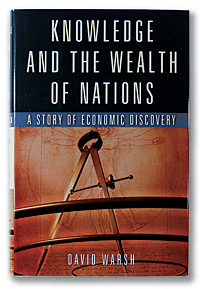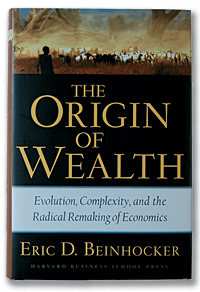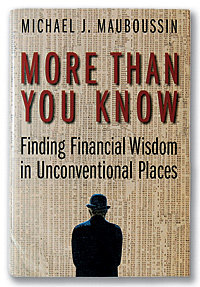Best Business Books: Economics
Making Theory Real
(originally published by Booz & Company) David Warsh,
David Warsh,
Knowledge and the Wealth of Nations: A Story of Economic Discovery
(W.W. Norton, 2006)
Eric D. Beinhocker,
The Origin of Wealth: Evolution, Complexity, and the Radical Remaking of Economics
(Harvard Business School Press, 2006)
Michael J. Mauboussin,
More Than You Know: Finding Financial Wisdom in Unconventional Places
(Columbia University Press, 2006)
For excellent reasons, effective executives traditionally view schoolbook economics with a mix of skepticism and mistrust. In their view, the equations are crudely simplistic even as their Greek letter formalism grows more grotesquely baroque. The widgets of Microeconomics 101, the allocative efficiencies of linear programming, and the Nobel Prize–winning Nash equilibria of game theory seem disconnected from market realities. They are like Sudoku for Ph.D.s — more puzzle-solving exercises than generators of actionable insights.
What technically gifted entrepreneurs and numerate managers have learned — or, more accurately, what they’ve been taught — about supply, demand, and dynamic equilibria hits the point of diminishing returns astonishingly fast. The grad school joke is that “In theory…” means something doesn’t work in practice, and “In practice…” means there’s no good theory. In global business, economics doesn’t buy executives much.
In fact, however, the past 20 years have seen enormous shifts in economic thinking as it moves closer to the reality of practitioners. Once-heretical ideas about monopolistic competition and growth have been mainstreamed. Truly laughable assumptions about perfect rationality and institutional behavior have been scrapped in favor of models that conceive markets as places where other things are decidedly not equal. Although the math is undeniably more elaborate than ever, the stories it’s telling are profoundly different. They speak to the real world, not just to idealized abstractions of it. Empirical phenomena once blithely ignored as too tough to model or conveniently declared irrelevant have acquired central roles in the ongoing narrative of economic understanding.
The result? Economics as science, discipline, and world view has been gaining a level of business relevance that simply did not exist even a generation ago. That’s not to say a command of contemporary economic thought dramatically improves chances for entrepreneurial success. However, giving serious thought to the models today’s economics devises and confronts offers serious executives far greater situational awareness of the dynamics that both define and drive profitable growth. That’s invaluable.
Three new books do a magnificent job detailing the (r)evolution in postmillennial economic thought. Each stands on its merits. Collectively, however, they form a comprehensive trilogy that captures the personalities, histories, concepts, and controversies reshaping the discipline’s most fundamental debates. More importantly, they could be useful: No one will look at the business implications of diminishing re-turns, increasing returns, modeling complexity, or the economics of ideas in the same way after reading them. Readers will — right along with the economists — think differently about what value creation can and should mean. Better yet, they won’t yawn while doing so. These books are accessible and even enjoyable.
 Epiphanies and Backbiting
Epiphanies and Backbiting
David Warsh’s Knowledge and the Wealth of Nations is the finest popular history of economic discovery since Nobel laureate George Stigler’s tangy 1988 autobiography, Memoirs of an Unregulated Economist. Mr. Warsh has taken a provocative 1990 academic paper (“Endogenous Technological Change,” by then 24-year-old University of Chicago economist Paul Romer) and used it as his window, lens, and X-ray machine to explore how economists have come to grips with the economics of intangibles. Modeling the possible role of “knowledge” in explaining economic growth, Professor Romer’s paper helped launch the “New Growth” school. Capital, labor, and technology are nice, but New Growth places the “marketplace of ideas” in the red-hot center of its economic development model. New ideas — and their diffusion — enable new growth. Innovation über alles.
Yes, the model was simplistic; yes, its mathematics was complex. But the paper’s core nimbly addressed one of the fundamental economic paradoxes reaching back to the days of Adam Smith. As Mr. Warsh observes:
The problem is that the two fundamental theorems of Adam Smith lead off in quite different and ultimately contradictory directions. The Pin Factory is about falling costs and increasing returns. The Invisible Hand is about rising costs and decreasing returns. Which is the more important principle? When Paul Romer read back over the literature, he found that one of his teachers had seen the dilemma perfectly clearly as a young man. In 1951 George Stigler [the author of the aforementioned autobiography] had written, “Either the division of labor is limited by the extent of the market and, characteristically, industries are monopolized; or industries are characteristically competitive and the [Invisible Hand] theorem is false or of little significance.” According to Stigler, they cannot both be true.
These are the bifocals of Adam Smith. Through one lens, specialization (as in the Pin Factory) leads to the tendency we describe as monopolization. The rich get richer; the winner takes all; and the world gets a steady supply of pins, though, perhaps, not enough to satisfy its need. Through the other lens, the situation we describe as “perfect competition” prevails. The Invisible Hand presides over pinmakers and all others. No manufacturer is able to achieve the upper hand. As soon as one raises his prices, someone else undercuts him. There are exactly as many pins as people are willing to buy. No one perceived the contradiction at the time. But then, it was only pins.
But the dichotomy between increasing and diminishing returns for “goods” and “innovations” offers astonishingly rich frameworks for exploring how “ideas,” “knowledge,” and “things” can be combined to model all manner of economic growth. The inherent tensions between increasing and diminishing returns can be used to model the rise of entrepreneurial innovation and industrial organizations, competition within a firm and between industries, regional economic growth, and global trade rivalries. New models and methodologies based on this central division have provoked fierce controversy and rivalry in academe’s econosphere.
Pivoting deftly between microeconomic and macroeconomic theorists, Mr. Warsh describes how economists of all stripes and pedigrees compete in their discipline’s global marketplace. He leaves no Nobel economist unlearned. From Paul Samuelson’s epochal departure from Harvard for MIT to the University of Chicago’s Milton Friedman–esque culture of intellectual rigor to Ken Arrow’s taking up residence in Stanford, Mr. Warsh presents the backstories, backbiting, and institutional rivalries — not just competing ideas — that drive innovative thinking in world-class universities. The cults and subcultures — the so-called invisible colleges — that truly govern academic disciplines seep into the larger narrative that Mr. Warsh has chosen to tell.
The idea development process is messy, vulgar, inefficient, and brilliant. Good concepts get lost as the inertia of an intellectual status quo is preserved by aging intellectual aristocrats with cruel tongues and long memories. Force of personality is often indistinguishable from force of idea. Academic conferences and workshops become battlefields where intellectual ambushes are sprung on unsuspecting scholars. Adam Smith had a reputation as a genuinely nice man; his intellectual descendants play rougher. It’s a hoot.
In this war of ideas, Henry Kissinger’s academic aphorism is just wrong: The battles are so vicious because the stakes are so intellectually large. That is, what really best explains how companies, industries, cities, and societies grow rich? Is there an E=mc2 of economic growth? Can there be?
A former Boston Globe economics columnist, Mr. Warsh brings a journalist’s sensibility to these questions. He does a terrific job of showing how seemingly disparate ideas — drawn from, for example, the economics of joining a club or running a ski lift — can utterly transform the way economists think about rivalry and exclusivity in markets for intellectual property. At every step along the way, economists are adopting, adapting, and discarding mathematical tools designed to formally explain a nugget of insight that a previous model left untouched.
What Mr. Warsh has written is a conversational but substantive sociology of economic model building around the idea of ideas in generating sustainable growth. To hear how a Nobel laureate like Robert Solow articulates his modeling philosophy versus how Nobel laureates Robert Lucas or Ken Arrow articulate theirs is to discover just how conceptually and technically idiosyncratic the field’s greatest minds can be. Readers gain insight into how high-level economists persuade their peers. By blending personality profiles and descriptions of the dueling mathematics, Mr. Warsh demonstrates both the economics and the politics of model building. This is how a science evolves. Yes, there are paradigm “shifts,” but there are also paradigm jerks, twitches, mirages, and meltdowns. Mr. Warsh comfortably describes them all.
Unfortunately, Mr. Warsh lacks both the quantitative and expository chops to take the mathematical models of Professors Romer, Arrow, or Solow and make them accessible to his readers. The book would have benefited from a successful deconstruction of the high math of New Growth theory into a narrative that let readers sense the virtues and limitations of formalism as a tool for thought. This is more than a quibble, because quantitative modeling is intrinsic to every issue Mr. Warsh addresses. And excising a malformed chapter on Microsoft’s monopoly travails would also have improved the book. The company’s adventures in antitrust really don’t resonate with the provocative “knowledge economics” themes that precede it.
 Evolution and Complexity
Evolution and Complexity
Eric D. Beinhocker’s The Origin of Wealth takes up the technical challenge that Mr. Warsh shirked. Where Mr. Warsh’s journalistic sensibility makes him an effective storyteller, Mr. Beinhocker’s consulting background has made him a master synthesizer who packages “big ideas” into accessible taxonomies and ecologies. Mr. Beinhocker nonetheless manages to spin fine yarns, but always in the service of exposition. He cheerfully describes the guts of “genetic algorithms,” “fitness landscapes,” and “random graph theory” in a manner that any reader can grasp. Although The Origin of Wealth is emphatically not The New Economic Paradigm for Dummies, it’s clearly written to focus on the technical essence of economic evolution. The intellectual overlap between Mr. Warsh and Mr. Beinhocker is both complementary and creative. Comparable themes are examined from starkly different perspectives.
Where Mr. Beinhocker really shines, however, is in his discussion of how “traditional economics” has been gradually supplanted by what he calls “complexity economics,” an adaptive system of constantly changing networks that reflect the evolutions of society, technology, and business. His review and dissection of the simplistic, misleading, and pathological assumptions that inform “equilibrium economics” is simply masterful. Without mockery, he shreds the silliness and outright intellectual dishonesty that has kept so many flawed economic theories in contemporary curricula and policy debates for so long. In one especially apt passage, he compares the economists who keep traditional theory alive by using mathematical tricks and gimmickry to the technically gifted gearheads in today’s Cuba who keep their 1950s Cadillacs running like new. They’re trapped in a time warp; let’s move on.
But to what? Here’s where Mr. Beinhocker’s commitment to technical exposition yields increasing returns. After disposing of such dysfunctional assumptions as “random walks” and quests for “optimal efficiencies,” Mr. Beinhocker embraces the new math and models of complexity economics. To do so, he draws heavily on research and ideas from places like the Santa Fe Institute, where biologists, physicists, and economists collaborate to see to what extent their mathematics and metaphors can help one another. But Mr. Beinhocker’s great accomplishment is to present a variety of the singular ideas that can be assembled into economic models that indeed help explain the “origin of wealth.”
Intriguingly, although he thematically brands these ideas around complexity, the narrative arc that integrates his insights is the principle of evolution. Mr. Beinhocker’s book is about the “evolvability of evolvability” in economic systems. That is, how do individuals and institutions collaborate and compete to create value? What institutions do they create? What information do they process, and how do they process it? When do they trade as individuals? As teams? As firms? As nation-states? How does new information — feedback — get incorporated into the heuristics and rules that govern decision making?
Where Mr. Warsh does a fantastic job of addressing how traditional economists deal with those questions, Mr. Beinhocker presents the broad array of mathematical tools and models that are better equipped than their predecessors to describe evolvability and adaptation. That’s not to say that traditional economic models and math are irrelevant or obsolete; it’s just that they’ve hit (ahem) diminishing returns.
So Mr. Beinhocker runs tutorials that cherry-pick from the interdisciplinary fields of software design, cognitive psychology, network theory, and genetic algorithms to explain how growth, knowledge, and growth of knowledge all happen. Not only are these tutorials well done, Mr. Beinhocker does what you’d expect an excellent consultant to do: He connects them to the real world of business practice. This can be a self-help book for executives seeking business insight from a different genre of economic modeling.
For example, Mr. Beinhocker uses the networking research of Santa Fe Institute complexity theorist Stuart Kauffman to better explain the economics of adaptation in the face of disruptive competition: “The work by Kauffman and the others leads to a counterintuitive insight. IBM’s problem with Dell was not that the blue-chip company was insensitive to change but rather that it was too sensitive to change. The dense interconnections and tangles of interaction in IBM’s business system meant that small changes (‘let’s sell computers by mail’) could cascade into big problems (‘here are the thousands of reasons why we cannot sell computers by mail’).”
In other words, highly networked enterprises may be far less adaptable in the face of competition than their champions argue. Traditional economists might assert that Nobel laureate Ronald Coase (who appears in both books) anticipated this situation in his classic paper on organizational coordination and transaction costs. Absolutely true. But Professor Coase was from the tradition of “literary economics,” which tells stories; the high-powered mathematical tools of network theory lets economists — and businesses! — build manipulable models. We can now “play” to learn where economies of scale (increasing returns) conflict with coordination costs (diminishing returns) in both organizations and industries.
Mr. Beinhocker’s book is filled with the insights and implications of these “evolutionary economics” tools. He extends them to business and finance. His discussion of how “evolutionary algorithms” offer the most useful intellectual resource in framing economics is remarkably clear and compelling. He’s done superb work in going beyond the metaphorical to give serious readers a sense of how the modeling media of “complexity economics” should transform the way that businesspeople perceive and manage innovation, risk, and opportunity. Even for readers familiar with the growing literature on complexity, chaos, and evolutionary design, Mr. Beinhocker’s commitment to business relevance makes his book a usable read as well as a good one.
The most significant criticism is one to be expected. Consultants with “big ideas” aren’t content to be superb synthesizers and explainers. They want to change the world as well. The last section of the book discusses the implications of these themes for business and society. Let’s just say that Mr. Beinhocker discusses the business implications with greater nuance, sophistication, and applicability than he does the social. Mr. Beinhocker is no doubt a superb business consultant; he’s overreaching when he takes on society as his client. Diminishing returns, indeed.
 Investing Post-Buffett
Investing Post-Buffett
Michael J. Mauboussin is an investment strategist who brings an investor’s sensibility and a lust for new ideas to his book More Than You Know. Incorporating essays and letters he wrote for clients while at Credit Suisse First Boston, More Than You Know is far more technical than the other two books but pithier and by far the most useful — and therefore the best of the year.
Every serious investor or executive who oversees capital allocation or innovation investments will find every other essay in this book of direct relevance to his or her work. Reminiscent of Nassim Taleb’s best-selling book Fooled by Randomness: The Hidden Role of Chance in the Markets and in Life (Texere, 2001), Mr. Mauboussin’s essays are rich in probabilistic analysis and insight. His integration of behavioral finance theory, traditional investment analysis, and complex adaptive systems serves as the organizing principle for every chapter in the book. Unlike Mr. Warsh and Mr. Beinhocker, Mr. Mauboussin is writing for a particular kind of reader: investment-oriented but not as risk-savvy as he or she should be, open to ideas but skeptical, and unafraid of a little math but without a lot of time to read.
Although this is not a mathematics-oriented text, anyone who wants to get real value from reading it should have a pencil and notepad at hand — not to work out problems but to annotate the ideas. The book invites the reader to conduct “back-of-the-envelope” modeling of risk and value management. It’s every bit as interdisciplinary as Mr. Beinhocker’s book, but also addresses the core historic economic assumptions that Mr. Warsh surveys so well. More Than You Know not only complements those two books, it reinforces and deepens their central themes. But it does so from an unabashed investment perspective where risk and reward alone determine what gets written. Mr. Mouboussin examines Paul Romer’s work, for example, from the standpoint of its investment implications.
Mr. Mouboussin clearly respects Warren Buffett’s investment philosophies — who doesn’t? — and his essays revolve around the notion that new theories of adaptive systems and risk assessment mean investors will literally have to reevaluate what fundamental means. His chapter titled “Strategy as Simple Rules,” based on work by Donald Sull and Kathleen Eisenhardt, is a model of useful synthesis for investors and managers alike who look to “define direction without containing it.” Do those rules reflect the same evolutionary rules Mr. Beinhocker discusses? Of course. But they’re discussed from a perspective that illuminates both works.
Because this book is a collection of previously published essays, it’s not as tightly constructed or as smooth as the others. Perhaps it is best read as a companion to books of broader sweep and greater depth. That said, the essays do speak directly to individuals who want their perceptions of risk and value shaken and stirred.
The timing of these three books is hardly coincidental. There’s not just something in the air; ideas are swirling and software is running that have successfully called into question assumptions that have been sacrosanct for centuries. The good news is that these are great questions. The better news is that we’re beginning to have great answers as well. That’s why these books are worth the investment.![]()
Author profile:
Michael Schrage (schrage@mit.media.edu) is the codirector of the MIT Media Lab’s e-Markets Initiative, senior advisor to the MIT Security Studies program, and the author of Serious Play (Harvard Business School Press, 1999).



